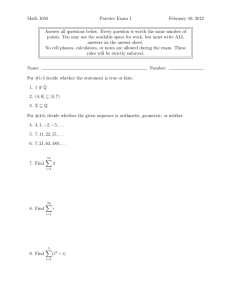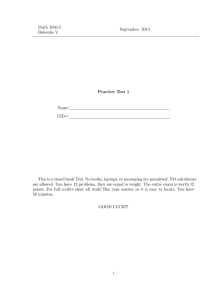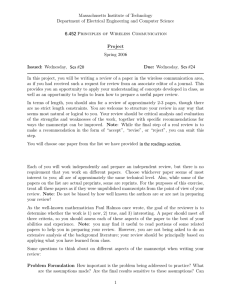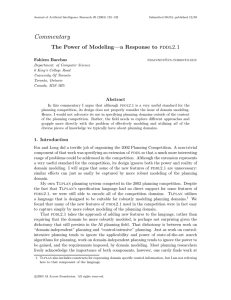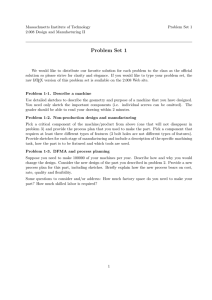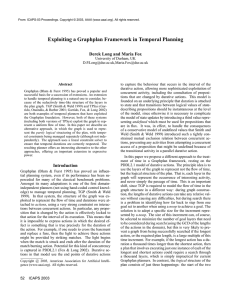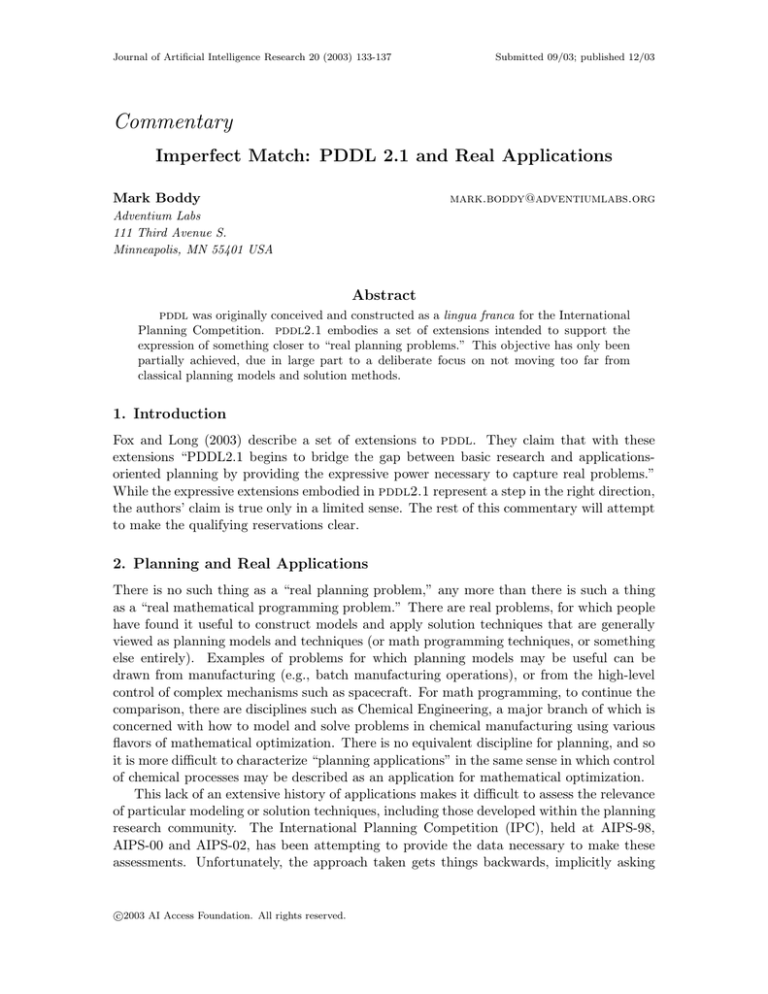
Journal of Artificial Intelligence Research 20 (2003) 133-137
Submitted 09/03; published 12/03
Commentary
Imperfect Match: PDDL 2.1 and Real Applications
Mark Boddy
mark.boddy@adventiumlabs.org
Adventium Labs
111 Third Avenue S.
Minneapolis, MN 55401 USA
Abstract
pddl was originally conceived and constructed as a lingua franca for the International
Planning Competition. pddl2.1 embodies a set of extensions intended to support the
expression of something closer to “real planning problems.” This objective has only been
partially achieved, due in large part to a deliberate focus on not moving too far from
classical planning models and solution methods.
1. Introduction
Fox and Long (2003) describe a set of extensions to pddl. They claim that with these
extensions “PDDL2.1 begins to bridge the gap between basic research and applicationsoriented planning by providing the expressive power necessary to capture real problems.”
While the expressive extensions embodied in pddl2.1 represent a step in the right direction,
the authors’ claim is true only in a limited sense. The rest of this commentary will attempt
to make the qualifying reservations clear.
2. Planning and Real Applications
There is no such thing as a “real planning problem,” any more than there is such a thing
as a “real mathematical programming problem.” There are real problems, for which people
have found it useful to construct models and apply solution techniques that are generally
viewed as planning models and techniques (or math programming techniques, or something
else entirely). Examples of problems for which planning models may be useful can be
drawn from manufacturing (e.g., batch manufacturing operations), or from the high-level
control of complex mechanisms such as spacecraft. For math programming, to continue the
comparison, there are disciplines such as Chemical Engineering, a major branch of which is
concerned with how to model and solve problems in chemical manufacturing using various
flavors of mathematical optimization. There is no equivalent discipline for planning, and so
it is more difficult to characterize “planning applications” in the same sense in which control
of chemical processes may be described as an application for mathematical optimization.
This lack of an extensive history of applications makes it difficult to assess the relevance
of particular modeling or solution techniques, including those developed within the planning
research community. The International Planning Competition (IPC), held at AIPS-98,
AIPS-00 and AIPS-02, has been attempting to provide the data necessary to make these
assessments. Unfortunately, the approach taken gets things backwards, implicitly asking
c
2003
AI Access Foundation. All rights reserved.
Mark Boddy
“how can we extend the models everybody in a particular community is comfortable working
with, so that they are closer to what we think is needed for a real application?”
If planning research is to be viewed as a discipline akin to mathematics, this kind of
extension from known theoretical constructs makes sense. If planning is engineering and
real applications are the point, theoretical work should emerge from, or at the very least be
tested against, generalization and abstractions of real applications. The classical planning
approach grew out of work on theorem-proving and dynamic logics, and ever since has
most fruitfully been applied in domains involving minimal interaction with the physical
world, which describes some planning domains (softbots and other software agent-based
applications, for example), but not the vast majority of them. Of the systems cited in Fox
and Long’s Introduction as having been applied to real planning problems (SIPE, O-Plan,
HSTS, and IxTeT), none are conventional classical planners constructing totally-ordered
sequences of operators. All of them use some combination of methods drawn from temporal
network planning and HTN (task decomposition) planning. Other work applying planning
methods to real applications, for example ASPEN (Fukunaga et al., 1997), does not make
much use of classical planning techniques, either. Perhaps classical planning is addressing
the wrong problem, or the wrong parts of the problem, for most real applications.
3. Evaluating the Language Itself
As argued by a long line of people going back at least to Hendrix (1973), a point-based
temporal model in which instantaneous events effect changes in the world state can be used
to build very expressive models of system dynamics, simply by treating those events as
the starting or ending points of intervals over which propositions hold or processes change
the world state. Over the past decade or so, Reiter (2001) and others have extended the
semantics of the Situation Calculus (McCarthy & Hayes, 1969) to encompass overlapping
actions, metric quantities, continuous change, exogenous actions, limited knowledge, contingent action effects, and actions with uncertain effects, among other things. As presented
by Fox and Long, pddl2.1 can be used to express many of the things one might want to
represent for a real problem. However, there is a difference between saying that something
can be expressed in a given language, and that that expression is natural, intuitive, or easy
to use.
Take the modeling of resources as an example: pddl2.1 is expressive enough to represent unary resources (trucks, tools), capacity resources (power, weight), and consumable
resources (fuel). But there is no easy way in the language to refer to properties of the
resource itself. Everything is encoded in the action representation, as for example in the
modeling of total-fuel-used in the example of Figure 5. In many real domains, resources
are primary, in the sense that the hard part of the problem is figuring out how to resolve
resource conflicts, within the other constraints in the problem statement.
3.1 Form Follows Function
The significance of the distinction between what can expressed and how easily it can be
expressed or manipulated depends on what roles the language is intended to fill. pddl2.1
is in its origins and current use a language for the planning competition. As long as
the current language permits the (not necessarily terribly natural) expression of required
134
Imperfect Match
features of the domain and planning problem, perhaps there is no problem. Competitors
who wish to construct special-purpose data structures such as explicit representations of
resources are free to do so.
If pddl2.1 is to be employed beyond the IPC, what role(s) are intended? A high-level
modeling language for real applications has very different requirements from a competition
standard, different again from a language used to pass planning problems and solutions
in machine-readable forms, different yet again from a modular, locally-extensible language
used as a research tool, permitting researchers to exchange example domains so as to be
able to compare results using different techniques on the same data.1
3.2 Specific Problems with the Language
Finally, there are some specific problems with the current semantics of pddl2.1, which
should be addressed pretty much whatever use it is to be put to.
3.2.1 Holdovers From the Classical Model
Fox and Long are explicit about having made choices in both syntax and semantics to keep
a familiar feel to the language for the classical planning community. This makes good sense
if the objective is to use the language to push the boundaries of what can be done using or
extending the models and methods currently popular in the research community, but does
little to support, and may in some cases actively hinder, the introduction of features drawn
from real applications.
There are several problems resulting from this stance. First, the language is explicitly
restricted to ensure a finite set of ground actions, specifically because some planning algorithms require this. This precludes the modeling of a number of different kinds of domain
features, for example the explicit creation and destruction of objects (e.g., intermediate data
products, in an image-processing application), or flexible solution for continuous parameters
(for example, trajectory optimization) within an existing or evolving plan. Shouldn’t the
models and methods be following the requirements of the problems to be solved, rather
than the other way round?
A second problem is the treatment of durative actions as atomic, rather than treating
activities like heating water or lighting matches as starting processes that may proceed on
their own, until the agent decides again to intervene. Consider the heat-water action
defined in Figure 12 of Section 5.3, whose duration is defined to be precisely that required
to raise the water to 100 C. This has the curious result that in any well-defined plan,
the duration of heat-water must be exactly the time required, taking into account any
overlapping actions that may also affect the temperature of the water, where those actions
may not be specified until after the heat-water action is added to the plan.
Finally, the authors define a semantics for durative actions in which preconditions are
required to be true at the beginning or through the extent of, and postconditions are
asserted at the end of, intervals of non-zero width open on the right. This is clean, clear,
and requires no special constraints to have a well-defined semantics, at least for totallyordered begin and end-points. at-end preconditions mess this up, and furthermore are the
wrong solution for what the authors appear to be trying to support, which I take to be the
1. For a summary of previous attempts to construct a shared ontology for planning, see Tate (1998).
135
Mark Boddy
implicit expression of complex structure within a durative action (“this action requires p to
be true for 2 minutes, from the start of the action”). See Dave Smith’s commentary, also
in this issue, for a discussion of what a more complete model of complex durative actions
might look like, if one were less concerned with staying close to the classical planning model.
3.2.2 Problems with the Definition of the Continuous Model
In Section 5.3, Fox and Long introduce a notation for specifying durative actions with continuous effects, claiming that using their #t notation, it is possible to express a variety of
different nonlinear functions of time. At least as presented in that section, the #t construction does not appear to permit the definition, implicit or otherwise, of nonlinear continuous
functions. In their example of expressing the effect of acceleration on position by making
velocity vary over time, evaluating position at #t by multiplying #t by a time-varying velocity also evaluated at #t will result in an incorrect answer. The required operation is
integration, not composition.
Also in that section, the authors say that continuous durative actions don’t support
exogenous events. I don’t understand why they can’t, as long as the endpoints of those
exogenous events also appear in the plan. Incorporating this capability would significantly
increase the range of real (or realistic) problems that could be represented.
3.2.3 Other Issues
Two other matters are worth pointing out as well. First is the restriction to numeric domains
for functions, for which a primary motivation cited is the previously-discussed objective of
making it possible to construct finite extensional models of the set of possible actions. Nonnumeric functions are frequently useful in real domains, for example to refer to the current
state of an object (the current configuration of a piece of communication equipment, say).
Finally, the authors’ decision to support “Undefined” values for numeric fluents is by
their statement intended to allow actions to determine fluent values by setting them, prior
to which the value would be unknown. Representing incomplete information, including
unknown propositional and continuous states, is an important capability, and one that
should be addressed directly. It might deliberately be left as a later extension but I do not
understand the merits of addressing it incompletely in this way.
4. Summary and Conclusions
The extensions embodied in pddl2.1 are a definite step in the direction of a language in
which complex planning problems can be expressed. Fox and Long have done the planning
community a considerable service, first, in designing and implementing those extensions, and
second, in presenting and motivating them in the current paper. The focus on backward
compatibility with classical planning is problematic, given their expressed desire to address
real (or at least more realistic) applications, and there are some other necessary cleanups
to the language, noted above.
Any further extensions to pddl2.1 will have to address the very likely fragmenting of
the field into mutually incompatible sub-fields. The logical end of this process can be seen
in the survey of scheduling problems compiled by Graham et al. (1977), in which minor
136
Imperfect Match
differences in problem statement lead to very different complexity classes. Classification by
complexity class may be less relevant in a field where almost every interesting problem is
at least NP-hard, but a similar phenomenon will arise from the fact that some problems
require different expressive capabilities than others (resource constrained project scheduling
problems, versus manuever planning for satellite constellations, for example), or are hard
to solve in very different ways (finding a correct ordering on plan steps, versus resolving
conflicts on a unary resource).
Ultimately, techniques developed in the classical planning literature will probably prove
useful in addressing complex, real-world applications. However, I do not believe that they
will in most cases be central to those solutions. The classical planning focus is on individual
actions, rather than organizing or synchronizing with operations in the larger environment,
on discrete state changes, rather than multiple, interacting asynchronous processes, and
on propositional representations, rather than constraints on continuous quantities. Other
methods will have to be brought to bear to address the core complexities of most real
“planning” problems, which involve complex resources and other forms of synchronized
behavior, exogenous events, temporal uncertainties in both the agent’s own actions and
other events, and in some cases, significant continuous dynamics.
As a final comment, my reservations regarding the current state of pddl2.1 should not be
taken as an argument against the utility of “toy” problems and abstract languages, especially
for such purposes as the IPC. However, the simplifications and abstractions employed should
preserve the appropriate structure, such that research results and understanding gained in
working with them can translate to real problems. This is where I believe that continued
focus on classical planning models and methods will be problematic.
References
Fox, M., & Long, D. (2003). Pddl2.1: An extension to pddl for expressing temporal planning
domains. Journal of Artificial Intelligence Research, ??
Fukunaga, A., Rabideau, G., Chien, S., & Yan, D. (1997). Aspen: A framework for automated planning and scheduling of spacecraft control and operations. In Proc. International Symposium on AI, Robotics and Automation in Space.
Graham, R., Lawler, E., Lenstra, J., & Rinnooy Kan, A. (1977). Optimization and approximation in deterministic sequencing and scheduling: A survey. In Proceedings Discrete
Optimization.
Hendrix, G. (1973). Modeling simultaneous actions and continuous processes. Artificial
Intelligence, 4, 145–180.
McCarthy, J., & Hayes, P. J. (1969). Some philosophical problems from the standpoint of
artificial intelligence. Machine Intelligence, 4.
Reiter, R. (2001). Knowledge in Action: Logical Foundations for Specifying and Implementing Dynamic Systems. MIT Press, Cambridge, Mass.
Tate, A. (1998). Roots of spar - shared planning and activity representation. Knowledge
Engineering Review, 13, 121–128.
137

